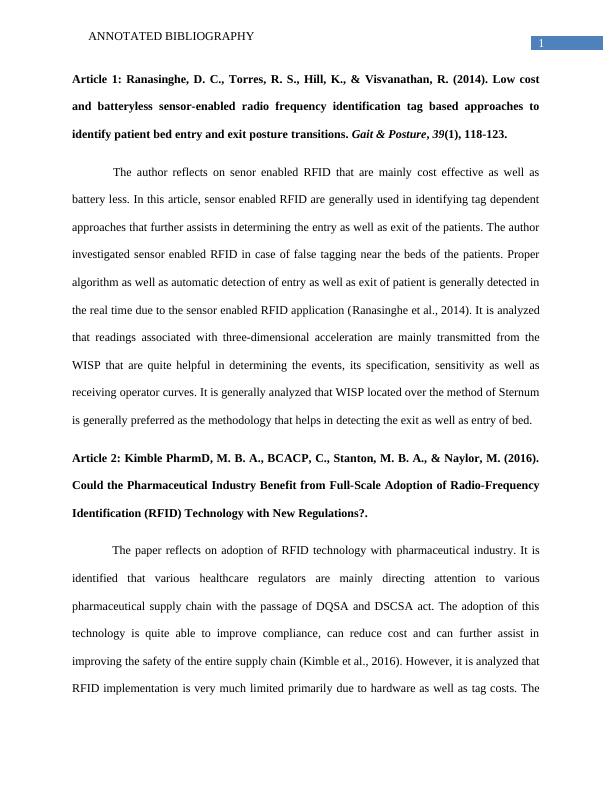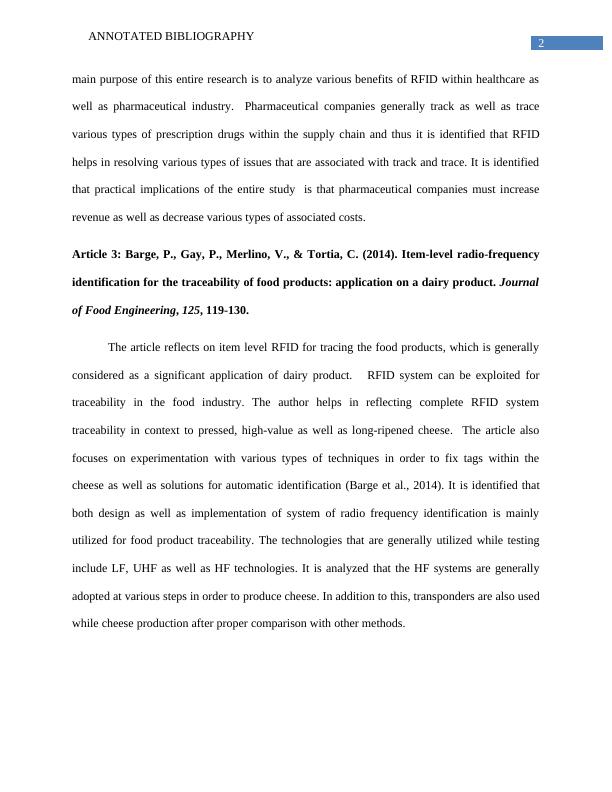Ask a question from expert
Sensor Enabled RFID | Article
11 Pages3030 Words433 Views
Added on 2019-11-19
Sensor Enabled RFID | Article
Added on 2019-11-19
BookmarkShareRelated Documents
Running head: ANNOTATED BIBLIOGRAPHYAnnotated Bibliography: RFIDName of the StudentName of the UniversityAuthor’s Note

1ANNOTATED BIBLIOGRAPHYArticle 1: Ranasinghe, D. C., Torres, R. S., Hill, K., & Visvanathan, R. (2014). Low costand batteryless sensor-enabled radio frequency identification tag based approaches toidentify patient bed entry and exit posture transitions.Gait & Posture,39(1), 118-123. The author reflects on senor enabled RFID that are mainly cost effective as well asbattery less. In this article, sensor enabled RFID are generally used in identifying tag dependentapproaches that further assists in determining the entry as well as exit of the patients. The authorinvestigated sensor enabled RFID in case of false tagging near the beds of the patients. Properalgorithm as well as automatic detection of entry as well as exit of patient is generally detected inthe real time due to the sensor enabled RFID application (Ranasinghe et al., 2014). It is analyzedthat readings associated with three-dimensional acceleration are mainly transmitted from theWISP that are quite helpful in determining the events, its specification, sensitivity as well asreceiving operator curves. It is generally analyzed that WISP located over the method of Sternumis generally preferred as the methodology that helps in detecting the exit as well as entry of bed.Article 2: Kimble PharmD, M. B. A., BCACP, C., Stanton, M. B. A., & Naylor, M. (2016).Could the Pharmaceutical Industry Benefit from Full-Scale Adoption of Radio-FrequencyIdentification (RFID) Technology with New Regulations?.The paper reflects on adoption of RFID technology with pharmaceutical industry. It isidentified that various healthcare regulators are mainly directing attention to variouspharmaceutical supply chain with the passage of DQSA and DSCSA act. The adoption of thistechnology is quite able to improve compliance, can reduce cost and can further assist inimproving the safety of the entire supply chain (Kimble et al., 2016). However, it is analyzed thatRFID implementation is very much limited primarily due to hardware as well as tag costs. The

2ANNOTATED BIBLIOGRAPHYmain purpose of this entire research is to analyze various benefits of RFID within healthcare aswell as pharmaceutical industry. Pharmaceutical companies generally track as well as tracevarious types of prescription drugs within the supply chain and thus it is identified that RFIDhelps in resolving various types of issues that are associated with track and trace. It is identifiedthat practical implications of the entire study is that pharmaceutical companies must increaserevenue as well as decrease various types of associated costs.Article 3: Barge, P., Gay, P., Merlino, V., & Tortia, C. (2014). Item-level radio-frequencyidentification for the traceability of food products: application on a dairy product.Journalof Food Engineering,125, 119-130.The article reflects on item level RFID for tracing the food products, which is generallyconsidered as a significant application of dairy product. RFID system can be exploited fortraceability in the food industry. The author helps in reflecting complete RFID systemtraceability in context to pressed, high-value as well as long-ripened cheese. The article alsofocuses on experimentation with various types of techniques in order to fix tags within thecheese as well as solutions for automatic identification (Barge et al., 2014). It is identified thatboth design as well as implementation of system of radio frequency identification is mainlyutilized for food product traceability. The technologies that are generally utilized while testinginclude LF, UHF as well as HF technologies. It is analyzed that the HF systems are generallyadopted at various steps in order to produce cheese. In addition to this, transponders are also usedwhile cheese production after proper comparison with other methods.

3ANNOTATED BIBLIOGRAPHYArticle 4: Zou, Z., Chen, Q., Uysal, I., & Zheng, L. (2014). Radio frequency identificationenabled wireless sensing for intelligent food logistics.Phil. Trans. R. Soc. A,372(2017),20130313.The paper generally reflects on RFID enabled wireless sensing for various intelligentfood logistics. It is identified that future applications as well as technologies are IoT mainly helpsin evolving the procedure of food for supply chain and for created various types of benefit to thebusiness. RFID and WSNs are generally considered as one of the enablers of key technologies(Zou et al., 2014). It is identified that intelligent tags that are generally powered with the help ofautonomous energy are mainly attached on objects helps in allowing the physical parametersincluding humidity as well as temperature for seamlessly integrating with the enterpriseinformation system over the internet. It is analyzed that IoT platform with two layer networkarchitecture are generally introduced that comprises of reader link and ad-hoc link betweenvarious readers which is mainly connected to the internet with the help of Wi-Fi. Article 5: Bahr, W., & Price, B. J. (2016). Radio frequency identification and time-drivenactivity based costing: RFID-TDABC application in warehousing.The article generally reflects on TDABC application in warehousing. The authorillustrates the utilization of RFID for accounting of warehouse services as well as cost. Timedriven activity based costing is generally enhanced within the real time for collecting varioustypes of RFID data about warehouse activities. This helps in allowing the managers ofwarehouse to complete the calculations accurately as well as instantly. TDABC based RFID isgenerally proposed as one of the novel application that is dependent on RFID technology. Theutilization of information that is mainly generated through RFID technology helps in identifying

End of preview
Want to access all the pages? Upload your documents or become a member.